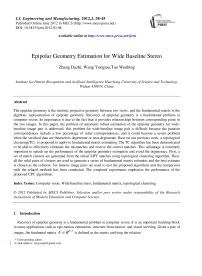Epipolar Geometry Estimation for Wide Baseline Stereo
Автор: Zhang Dazhi, Wang Yongtao, Tao Wenbing
Журнал: International Journal of Engineering and Manufacturing(IJEM) @ijem
Статья в выпуске: 3 vol.2, 2012 года.
Бесплатный доступ
The epipolar geometry is the intrinsic projective geometry between two views, and the fundamental matrix is the algebraic representation of epipolar geometry. Recovery of epipolar geometry is a fundamental problem in computer vision. Its importance is due to the fact that it provides relationships between corresponding point in the two images. In this paper, the problem of automatic robust estimation of the epipolar geometry for wide-baseline image pair is addressed. this problem for wide-baseline image pair is difficult because the putative correspondences include a low percentage of inlier correspondences, and it could become a severe problem when the veridical data are themselves degenerate or near-degenerate. Base on our previous work, a topological clustering(TC) is proposed to apply to fundamental matrix estimating. The TC algorithm has been demonstrated to be able to effectively eliminate the mismatches and reserve the correct matches. This advantage is extremely important to speeds up the performance of the epipolar geometry estimation and avoid the degeneracy. First, a set of match clusters are generated from the initial SIFT matches using topological clustering algorithm. Then, all the valid pairs of clusters are used to generate a series of fundamental matrix estimates and the best estimate is chosen as the solution. Six famous image pairs are used to test the proposed algorithms and the comparison with the related methods has been conducted. The compared experiments emphasize the performance of the proposed CPC algorithms.
Computer vison, Wide baseline stero, fundamental matrix, topological clustering
Короткий адрес: https://sciup.org/15014309
IDR: 15014309
Список литературы Epipolar Geometry Estimation for Wide Baseline Stereo
- P.H.S. Torr, and D.W. Murray, "The development and comparison of robust methods for estimating the fundamental matrix," International Journal of Computer Vision, vol. 24, no. 3, pp. 271–300, 1997.
- M. A. Fischler, and R. C. Bolles, "Random sample consensus: A paradigm for model fitting with applications to image analysis and automated cartography," Communications of the ACM, vol. 24, no. 6, pp. 381–395, 1981.
- P. H. S. Torr, and A. Zisserman, "MLESAC: a new robust estimator with application to estimating image geometry," Computer Vision and Image Understanding, vol. 78, no. 1, pp. 138–156, 2000.
- H. Wang and D. Suter, "Robust adaptive-scale parametric model estimation for computer vision," IEEE Trans. Pattern Anal. Machine Intell., vol. 26, no. 11, pp. 1459–1474, 2004.
- L. Moisan, and B. Stival, "A probabilistic criterion to detect rigid point matches between two images and estimate the fundamental matrix," International Journal of Computer Vision, vol. 57, no. 3, pp. 201–218, 2004.
- Y. T. Wang, D. Z. Zhang, J. W. Tian, "Topological clustering and its application for discarding wide-baseline mismatches," Optical Engineering, vol. 47, no. 5, pp. 057202-1- 057202-6, 2008.
- D. Lowe, "Distinctive image features from scale-invariant keypoints," International Journal of Computer Vision, vol. 2, no. 60, pp 91-110, 2004.
- R. Hartley , A. Zisserman,. Multiple View Geometry in Computer Vision, 2nd ed Cambridge University Press, 2000.
- T. Tuytelaars, and L. V. Gool, "Matching widely separated views based on affine invariant regions," International Journal of Computer Vision, vol. 59, no. 1, pp. 61-85, 2004.


